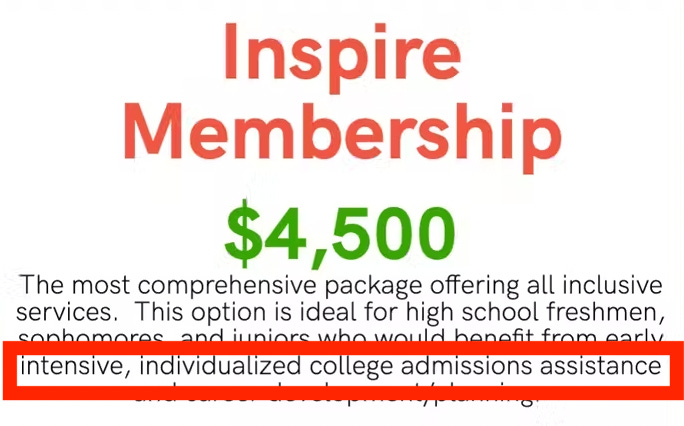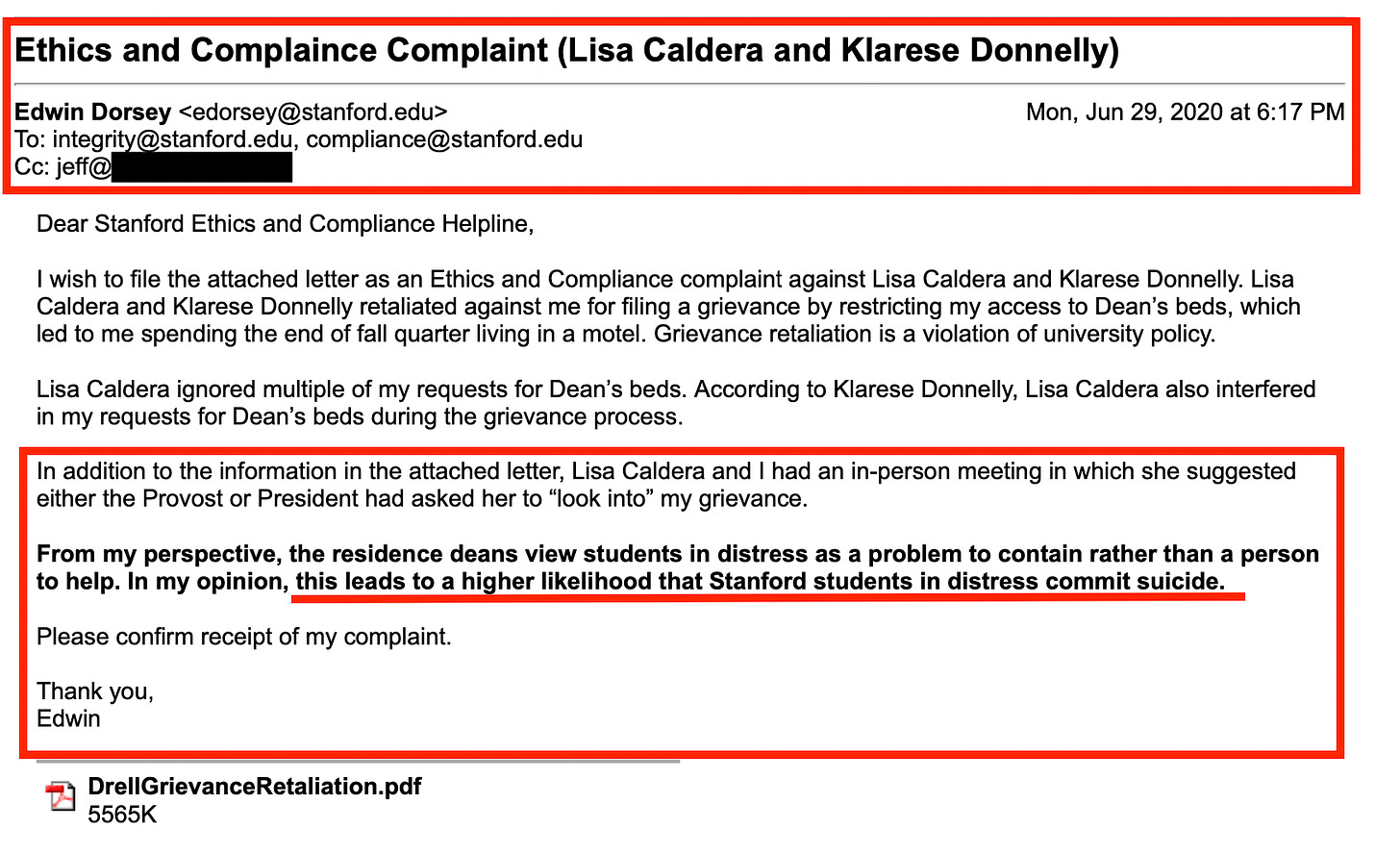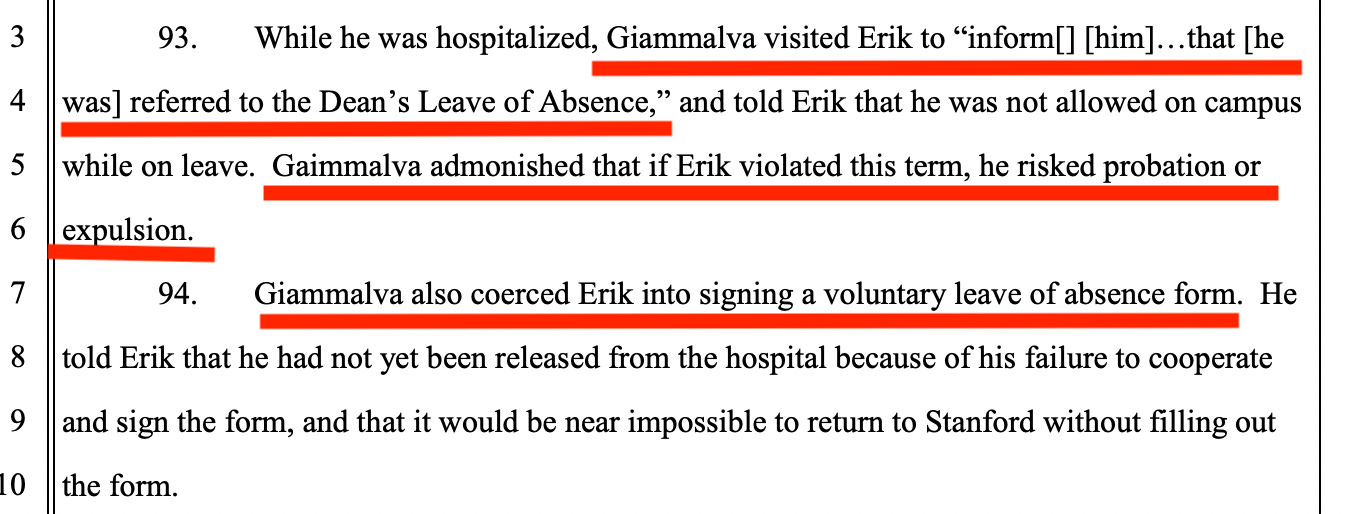Stanford’s President and Provost Must Resign
Twelve Student Deaths, Corruption, Coverups, Lying to WSCUC Regulators, and Lawsuits
Under President Marc Tessier-Lavigne and Provost Persis Drell, Stanford has had twelve student deaths and a student death rate ~500% above its historical average. Stanford now has the highest student death rate of any major university in the country.
President Tessier-Lavigne’s administration might be playing a role in causing student deaths.
Here is a brief summary:
Stanford Dean Lisa Caldera is the lead Dean in charge of “students in distress” and preventing student suicides. Dean Caldera also runs a side consulting business offering “individualized college admissions assistance” for upwards of $4,000 an applicant.
Dean Caldera offers a wide variety of “admission assistance” packages as well as hourly consulting and has alluded to ties with Stanford athletics.
On March 1, 2022, Stanford student Katie Meyer died by suicide. During that time, Dean Caldera was running a raffle for her side consulting business.
In June 2020, Stanford’s Ethics Office and Stanford’s Chairman received a formal Ethics complaint about Dean Caldera and the potential for more student suicides. Stanford never followed up.
Five students have died by suicide since President Tessier-Lavigne’s administration and Chairman Jeff Raikes ignored the ethics complaint about Dean Caldera.
President Tessier-Lavigne’s administration may have misled parents about the causes of some Stanford student deaths.
Two Stanford faculty are currently suing the University after their son, Eitan Weiner, died in a fraternity bathroom. The lawsuit alleges Eitan “died as a result of Stanford's knowing and intentional failure to follow its own policies and procedures.”
President Tessier-Lavigne’s administration publicly criticized the lawsuit and called the allegations “unfounded.”
An investigative document never previously published appears to contradict Stanford’s statements regarding Eitan’s death. The document alleges a Stanford Residence Dean marked Eitan’s initial overdose as a “non-priority” and waffled on calling 911.
The main Residence Dean in that case, John Giammalva, has also been accused of repeated misconduct in 2018 litigation filed by Disability Rights Advocates, a non-profit group that sued Stanford over its treatment of students with mental health struggles. Dean Giammalva continued to be employed by Stanford after the 2018 litigation and continued to be employed after Eitan’s death.
In another case, a student used the word “suicide” over 100 times in an essay. That student later died and the death was classified “an accident” by President Tessier-Lavigne’s administration.
President Tessier-Lavigne’s administration has fired some student support staff for financial reasons and is now installing surveillance cameras outside all student residences.
In May 2021 WSCUC, Stanford’s accreditation regulator, launched a formal investigation into President Tessier-Lavigne’s administration.
In an unsigned and undated letter, President Tessier-Lavigne’s administration lied repeatedly to WSCUC investigators.
President Tessier-Lavigne’s administration forged and destroyed critical case notes and fired a low-level administrator that spoke out against the administration’s misconduct.
During the six-year administration of Presider Tessier-Lavigne and Provost Drell, twelve students have died. During the 16-year administration of their predecessors, only six students died*
Anyone with additional information can contact me at: edwin@585research.com, the Stanford Board at: boardoffice@stanford.edu, and WSCUC’s President here.
Overseeing dozens of staff responsible for student well-being at Stanford is Dean Lisa Caldera. In interviews, Dean Caldera speaks passionately about being “invested in caring for students through critical life and college experiences.” In her job description, she is responsible for “connecting students in crisis with appropriate resources [and] development of student staff training programs.”
In an interview with Stanford News, Dean Caldera said,
“Each day I rise, it is with the intent to learn more about myself and to help support one more student than I did the day before.”
The article notes that Dean Caldera is also “a vinyl record enthusiast and a passionate gardener who grows pumpkins each year.”
More recently Dean Caldera has developed another hobby: college admissions consulting.
On Instagram and Facebook, Dean Caldera has dedicated pages for a variety of services including “coaching, consulting, and content development.” Dean Caldera’s Instagram also links to another site hosted on the “milkshake app.” That site has higher-touch services offered by Dean Caldera. For example, for $4,500 college applicants can get the “Inspire Membership” which includes “individualized college admissions assistance.”

Dean Caldera’s post adds that “flexible payment options are available.” At the bottom of the milkshake app page for the “Inspire Membership” is an option to schedule an initial consultation. That button takes customers to a private Google Doc onboarding form welcoming them to “the Caldera Community.” It begins, “We want your college planning process to be a highly personalized experience.”
On the intake form for Caldera College Consulting, customers can suggest time availability Monday-Sunday in the Morning, Midday, Afternoon, and Evening. On Instagram Dean Caldera has also shared a direct deposit link to her Venmo bank account so customers have “an easy way to connect to my services.”


In a one-year anniversary post, Dean Caldera disclosed having about 30 clients. Another post from Caldera College Consulting shows the Stanford Women’s Softball team, a picture of athletes wearing Stanford gear, and an image of the roster. The post reads, “taking a moment to shine a light on our student-athletes.”
One of Dean Caldera’s older marketing posts is titled, in part, “My mind on my money and my money on my mind.” Dean Caldera writes, “The recurring theme in my college experience was believing that I never had enough money… I am still working to heal my relationship with money.”
Dean Caldera’s moneymaking “college admission assistance consulting” may be interfering with her main job preventing Stanford student suicides.
For example, a February 26 2022 Instagram post from Dean Caldera reads, in part,
“Waking up to 1 year of Caldera College Coaching & Consulting was so amazing!! Girl power, facials, and Starbucks… #CalderaCommunity”
Three days later, Katie Meyer, a Stanford student RA under Dean Caldera, died by suicide. Katie was a Stanford soccer star and months away from graduation. Her death was the fourth Stanford suicide that year. In an interview with NBC News, the Meyer family talked about Katie’s death and said they believed it was triggered by an email over a disciplinary infraction:
“The last couple days are a parent’s worst nightmare and you don’t wake up from it… We have not seen that email yet. She had been getting letters for a couple months. This letter was kind of the final letter that there was going to be before ‘a trial.’ This is the only thing we can come up with that triggered something…We are just struggling right now. We are just struggling to know what happened and why it happened.”
Dee Mostofi, Assistant Vice President of External Communications at Stanford, told media outlets, "We are not able to share information about confidential student disciplinary matters."
Stanford’s former Chairman, Jeff Raikes, tweeted that he was “shocked and saddened to learn of Katie’s passing.” In a March 8 Facebook post Stanford said, “Over this difficult period, we have watched as the Stanford community has come together to help each other through the truly unimaginable.”
In June 2020, I filed an Ethics complaint with Stanford’s Ethics Office, Stanford’s Compliance Helpline, and Stanford’s then-Chairman Jeff Raikes about Dean Caldera and some of Stanford’s disciplinary staff. The email warned of the potential for more student suicides and said, in bold,
“The residence deans view students in distress as a problem to contain rather than a person to help. This leads to a higher likelihood that Stanford students in distress commit suicide.”

Stanford confirmed receiving the complaint and said they were investigating. Two weeks later, without ever contacting me, the Stanford Ethics Office said it “considered the matter closed” because my claims did not fall under Stanford policy.
The Stanford Ethics Office refused to explain its decision, never requested information from me, and stopped responding. In March 2022, I sent another email to the Stanford Ethics Office, former Chairman Jeff Raikes, and the Office of Current Chairman Jerry Yang. It said,
“Dean Caldera continues to violate Stanford policy and Stanford’s inaction will lead to more student suicides. Please let me know if anyone at Stanford is available to talk. I’m [phone number].”
Chairman Jerry Yang, ex-Chairman Jeff Raikes, and the Stanford Ethics Office didn’t respond.

The Stanford Dean responsible for preventing suicides has been subject to a formal ethics complaint, runs a side “college admission assistance” consulting business, had a student RA commit suicide, and has overseen a record-setting student death rate — and President Tessier-Lavigne has done nothing. Why?
One reason could be these problems run deep — too deep.
For example, look to the Santa Clara County Superior Court, where two Stanford faculty filed a wrongful death lawsuit against Stanford for the death of their son in a Stanford fraternity bathroom. Their son, Eitan Weiner, died as a 19-year-old Stanford Sophomore after an accidental overdose from fentanyl-laced Percocet pills.
The lawsuit claims Eitan “died as a result of Stanford's knowing and intentional failure to follow its own policies and procedures.” The lawsuit highlights that Eitan initially overdosed on January 15, 2020. However, Stanford administrators waffled on calling 911 after learning of the first overdose and, after Eitan overdosed a second time, he was discovered dead in a bathroom by janitorial staff on January 17.
Eitan’s sister, a Stanford graduate, told ABC News the family decided to file the wrongful death lawsuit right before the statute of limitations expired because:
“We knew Stanford was going to get to a point where they weren’t going to be compelled by any means to do anything and this was our last option.”
In a public January 2022 press release on Stanford News, President Tessier-Lavigne’s administration responded aggressively to the lawsuit writing, in part,
“Criticisms of the actions of our professional staff, in this case, are unfounded; their actions were timely and reasonable based on the information they had at the time… it is not accurate that Stanford failed to take appropriate actions following Eitan’s death.”
An Internal Stanford Investigative Appeal Document, never previously published, appears to contradict the statements of President Tessier-Lavigne’s administration. The unsigned and undated document, which appears to be a report commissioned by the fraternity where Eitan died, finds numerous flaws.
The second page of the document states that once the RA learned of the overdose, he contacted the Residence Dean responsible for the fraternity, John Giammalva, who “chose not to get involved” because “he was off work.”
Instead, according to the investigative document, the overdose was referred to Residence Dean E.J. (“Emma”) Madarasz. However, she marked the overdose as a “non-priority” and referred the matter back to Dean Giammalva to handle the next day.
Ultimately, according to the document, alarm bells went off when the unisex bathroom door was found locked at 11pm on January 16. 11 hours later, Stanford custodial staff used a master key to open the door and found Eitan Weiner’s dead body.
The document also mentioned that “there is no evidence the University has taken any steps to address the failure of the two Stanford Residence Deans to intervene.” A footnote in the document mentions another investigatory report that reportedly found, “Stanford employees did virtually nothing.”
This is not the first time Residence Dean John Giammalva has been involved in controversy.
In May 2018, Disability Rights Advocates, a non-profit group, sued Stanford over its treatment of students with mental health struggles. The lawsuit centers around a mandatory leave policy enforced by President Tessier-Lavigne’s administration that forces depressed students to leave campus, often against their own wishes.
The lawsuit mentions Giammalva repeatedly. In one case, Giammalva allegedly threatened to ban one student from his dormitory – that student later asked hospital staff to be present when Giammalva was around.
Another student alleged Giammalva coerced him into signing a leave of absence form while hospitalized.
Residence Dean Giammalva continued to be employed after the May 2018 lawsuit alleging repeated misconduct, continued to be employed after Eitan’s January 2020 death, and was allowed to quietly depart Stanford in July 2021.
Likewise, E.J. (“Emma”) Madarasz continued to be employed after Eitan’s January 2020 death and departed in May 2021 after less than two years. On her LinkedIn, she cited her experience in “high stress crisis management scenarios where execution and confidentiality are imperative.”
In sum, 1) An internal Stanford document finds repeated failure by Stanford staff, 2) Both Giammalva and Madarasz quietly depart Stanford, 3) Giammalva has been accused of past misconduct, and 4) the Dean overseeing all this, Lisa Caldera, has been the subject of an ethics complaint. Despite this, President Tessier-Lavigne’s administration released a public statement in January 2022 chastising the lawsuit from two Stanford faculty over their dead son and called any criticism “unfounded.”
These are no isolated incidents. On March 7 2019 Stanford cyclist Kelly Caitlin died by suicide in what was her second suicide attempt that year. Between the first suicide attempt and the second one, Stanford denied Kelly access to two psychologists she requested on campus. Mark Caitlin, her father, told the San Francisco Chronicle,
“I am sorry, but they could have done more for Kelly, enough to save her life.”
In a different case, a Stanford student wrote an essay for Stanford Professor Christopher Kamrath that used the word “suicide” over 100 times. That student later died and the death was classified “an accident” by President Tessier-Lavigne’s administration.
President Tessier-Lavigne’s administration has made the situation worse with mandatory leaves and forced hospitalizations. These policies lower legal risk for President Tessier-Lavigne’s administration, but often leave distressed students unable to trust Stanford.
In March 2021, the Stanford Daily interviewed students about whether they felt comfortable sharing mental health issues under President Tessier-Lavigne’s administration. According to the article, none did:
“Out of the ten students interviewed by The Daily, all said they had experienced suicidal ideation or thoughts of self-harm. When asked if they would consider sharing these concerns with a [Stanford] clinician all said they would not over fears surrounding the University’s involuntary leave policy.”
Last month, the Stanford Daily polled the Stanford community again. Here’s what they said:
“Mental health at Stanford is an afterthought. The administration’s neglect is single-handedly responsible for my breakdown. I spent 45 minutes on hold with [Stanford] during an emergency trying to get help before my parents rushed to get me.” — Sophomore
“I don’t feel supported at all by the mental health resources and staff at Stanford. I think the support they advertise for mental health is all a façade.” — Sophomore
“The mental health resources at the University are abysmal.” — Ph.D. student
“No help when we needed it — had to fly out from the East Coast to save my son myself.” — Parent
“I got upset and hung up on the crisis line. They didn’t call back or follow up in any way.” — Co-term/master's student
“I've never experienced a place that talks the talk so hard but can't begin to walk the walk. It's really saddening, and it's ultimately perpetuated by the school's administration.” — Senior
On April 21, the Stanford Daily editorial staff published a column about Stanford’s crisis titled,
“Letter from the editors: Something needs to change.”
That same day, President Tessier-Lavigne’s administration announced changes to install cameras across student residential buildings:
“Beginning this summer, Stanford will install security cameras at several residential buildings… Future project phases will cover more residences, ultimately leading to cameras outside all student residences.”
The camera surveillance changes drew sharp criticism from Stanford’s Faculty Senate.
On a similar note, leaked emails show a Vice Provost under Provost Drell wrote that some student support positions were being eliminated because “we have identified more efficient ways to complete financial transactions in a timely fashion.” The email noted, “we appreciate your… willingness to be collaborative, innovative, flexible, intentional, reflective, and excellent in supporting fellow students.”

Deaths are preventable if Stanford meets student distress with compassion, instead President Tessier-Lavigne’s administration fights loneliness with surveillance, listlessness with bureaucracy, and depression with involuntary expulsions.
People need love the most when they deserve it the least — President Tessier-Lavigne’s administration has demonstrated the opposite.
Because the Stanford Ethics Office did not engage with my complaints in June 2020, I reached out to the Department of Education’s Office of Inspector General. The case agent within the Department of Education recommended I take my concerns to WSCUC, Stanford’s powerful regulator and accreditation commission.
In September 2020, I filed a formal complaint against Stanford to end “the long history of senseless suffering inflicted by Stanford’s Provost, Persis Drell, and her administration.”

President Tessier-Lavigne’s administration responded in an unsigned letter that I believe was designed to mislead regulators. The letter lies about the date of certain events, lies about the materiality of events, lies about the nature of events, lies by omission, and created a fiction to deceive regulators.
Not only did President Tessier-Lavigne’s administration deceive WSCUC regulators, but the two and only original investigative case notes that provided a direct glimpse into the matter were destroyed and forged. It is unlikely that this is an isolated incident. In addition, the one administrator that went against President Tessier-Lavigne’s administration was later “laid off” around the time I raised public criticism.
In a May 2021 letter to WSCUC regulators, President Tessier-Lavigne’s administration wrote,
“Mr. Dorsey’s complaints were thoroughly investigated and found to be without merit… the University did not continue to engage with him regarding this matter.”
Stanford now has the highest student death rate of any WSCUC-accredited University. Its WSCUC accreditation is up for review this coming academic year.
Persis Drell must resign as Stanford’s Provost. Marc Tessier-Lavigne must resign as Stanford’s President.
Join the fight for accountability:
If you have information you would like to share, please contact me at edwin@585research.com or the Stanford Board at boardoffice@stanford.edu
If you or someone you know is in crisis, call the National Suicide Prevention Lifeline at 1-800-273-TALK (8255).
*Stanford student death rate was calculated based on memorial declarations and excluded deaths outside the sphere of Stanford and its programs such as deaths due to terminal illnesses unrelated to Stanford, like brain cancer, or car crashes. This article represents the opinions of Edwin Dorsey.











Just a note... you misspelled JT Chipman's name. It's Chipman, not Chapman. Also, there was no evidence that JT died by suicide.... I don't think it would be right to include him on the list of students above.